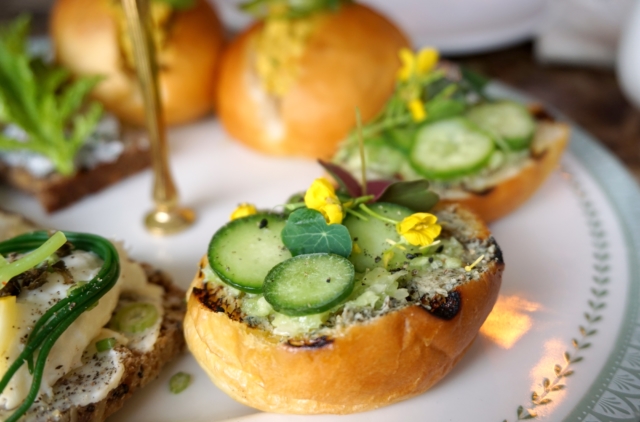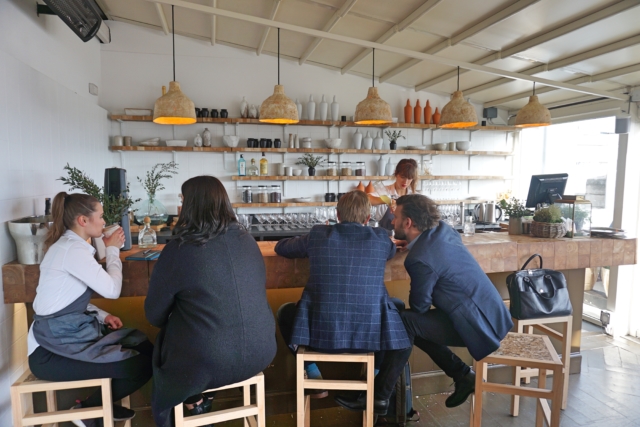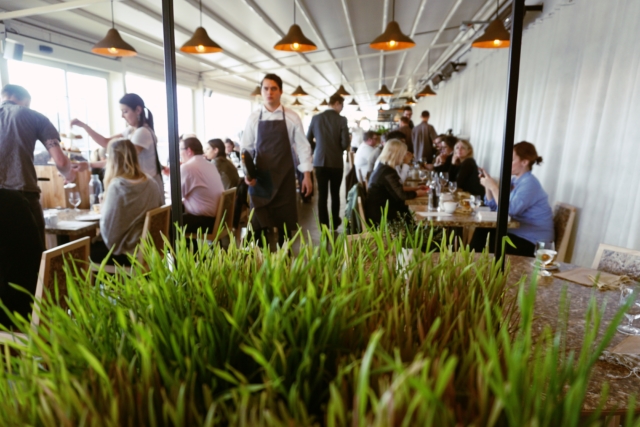The wastED tea pop-up I was lucky enough to enjoy on the roof at Selfridges on Wednesday (since it’s a pop-up unfortunately it’s only around until 2nd April and tables get booked out quickly so be sure to secure yours) was an afternoon tea that I was excited about the moment I booked. Knowing that two amazing and world-renowned chefs (Dan Barber and Yotam Ottolenghi) as well as an incredible tea expert (Henrietta Lovell) were behind it was already enough to get me bouncing up and down in anticipation.
The fact that the food was not just a food but a medium for a message, or rather a medium to nudge us to think about food and different food parts (those usually discarded in some parts of the world) in a more open way, made me tap my feet together and start dancing (well almost, but such was my excitement!).
WastED showcases and EDucates about ingredients-in-the-rough (waste) from local food producers and purveyors that might otherwise never have made it onto our plates by cooking up wonderful dishes at Selfridges for lunch, dinner, and tea. Coming from an anthropology background I learnt tons about food issues including waste, which does not only mean food that we can’t finish or that has gone bad, but also food with blemishes or irregularities in shape and size, and food parts that we consider inedible or don’t know what to do with, and that consequently don’t even make it to the consumer market.
Mostly, I learnt how to think critically about such issues and what we consume how and why. It’s a way of thinking that opened a whole new world of investigation and self-reflection for me that I hope to transmit to you as well (if it hasn’t already taken hold of you), because how we think (and consequently act) really does matter.
Chef Dan Barber learnt this from experience and is trying to make a change by showing consumers how foods we would usually consider waste can actually be incredibly delicious. His emphasis has been on regional and seasonal foods, working with the amazing and yet humble ingredients nature has to offer on his Blue Hill farm at Stone Barns in New York State. The dishes on offer any given day at the Blue Hill restaurant are taken from the surrounding fields and pasture, as well as from other local farms.
Dan Barber listens to what the environment is telling him to grow and then offers incredibly creative, inspiring, and delicious dishes to his guests without allowing any by-products to go to waste, simply because he does not treat them as such. Why, for example, waste the leaves of radishes when they have a beautiful aroma and can contribute to or even play the lead role in an amazing dish? By-products are not by-products, but simply products of our actions of how we treat the land and animals. They are far from mere accidental results that can be ignored and discarded. But rather than merely making the case that we should act more responsibly, we should also stop to realize that we are dealing with a case of loss. Why discard food that we can actually enjoy and find pleasurable?
Reflection on this kind of question is something the wastED six-week pop-up at Selfridges (lunch, afternoon tea, and dinner can be booked and had until 2nd April) is attempting to tickle out but without appearing preachy. If you are interested in finding out more about any single dish, waiters are happy to give you additional information or (if they are not sure) to go and find out. The focus, however, is on a pleasurable and delicious experience, because ultimately that is why so many cultures enjoy and even cherish certain food parts which other cultures discard as waste. While often these arose out of necessity, the fact that people take pleasure and even pride in eating them does not make them any less creative or valuable.
Moving away from status or trends, let’s see wasted foods the way they have been integrated into restaurant dishes by talented chefs as simply delicious – much like the team behind wastED London has done, with a gigantic list of big-name chef collaborators such as Alain Ducasse, Gordon Ramsay and Pierre Koffmann. Then we can take this inspiration and start thinking about incorporating them in our own cooking at home.
As for the afternoon tea experience at wastED, Selfridges? The somewhat amusingly titled Rye & Rejected Grain Bread caught my attention and led me to inquire why exactly it had come to be rejected. Grains that stand out from the uniform shape and size of most others are sorted out by a machine during the packaging process and are then usually discarded. Not so the grains used for this bread that afternoon. A new thing learnt and a step in a new direction – for suppliers, chefs, consumers, and the environment.
Similarly for the Cascara brew, which as a curious customer I ordered as an extra drink, where the discarded parts of the coffee bean are used but then brewed like a tea rather than a coffee. It did indeed taste like a mixture between tea (due to its thin consistency) and coffee (although the caffeine content was minor it was still strongly felt). It’s a concoction that shows that some new products take some getting used to – after all, as food writer and historian Bee Wilson would confirm, taste isn’t made in a day. Indeed, the learned nature of taste over time implies the possibility of change in eating habits and appreciation of different textures and flavours. More on this in a future article.
The Oolong Tai Guan Yin from Anxi in China, chosen by teamaster Henrietta Lovell, was pure and delicate in taste and wonderfully complemented the whole food ensemble. Amongst the sandwiches, my personal favourites were the airy and soft whey bread with cucumber scraps, “after dashi” kombu butter and foraged herbs, as well as the creamy yet light cod head bacalao mantecato and monk’s beard. What stood out for me in the Cake & Pastries section were the flavour-rich rhubarb ends and custard with campari and milk solids crumb, as well as the rich bloomed chocolate and peanut tart with crisps crumb.The scones were light but crunchy and the jam an unusual but delicious mix of pineapple, bergamot, and botanicals.
Ottolenghi’s own participation in the afternoon tea unfortunately ended on the 24th March, but there are still many chefs’ creations still to be enjoyed with a soothing cup of tea. Although, as I mentioned, waiters were happy to provide information, it would have been nice to be able to read about the story of at least some of the foods’ journeys in the form of a little additional nugget of information straight on the menu. After all, the effort behind the pop-up was incredible: a year of research, planning and preparation, unlike the three months of preparation that had gone into the preceding wastED project in the city of New York. But as long as it’s delicious the ED in education can begin to slowly unfold. We’ve started the conversation and we’re enjoying the food as well.
Area: Marylebone, Central London
Closest tube: Bond Street (Central and Jubilee line); Marble Arch (Central line); Oxford Circus (Central and Victoria line)
Address: Selfridges wastED pop-up
400 Oxford St
London
W1A 1AB
Until: 2nd April
Website: http://www.wastedlondon.com/ and make sure to book a spot for lunch/dinner/tea
Price for afternoon tea: £32 per person




